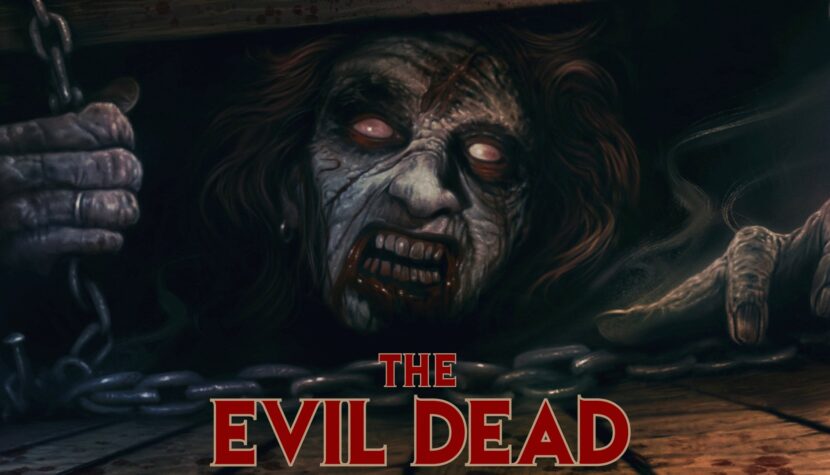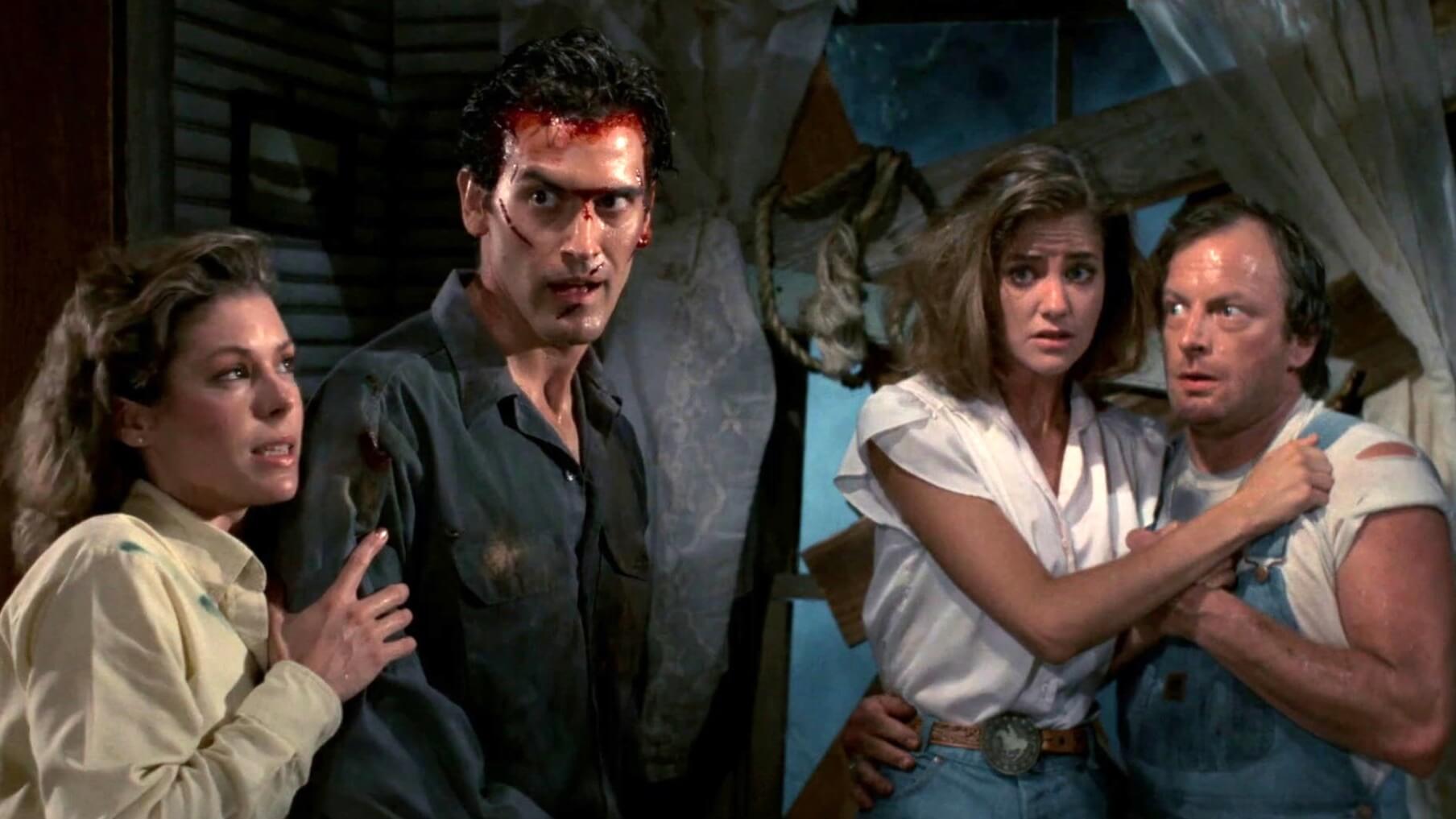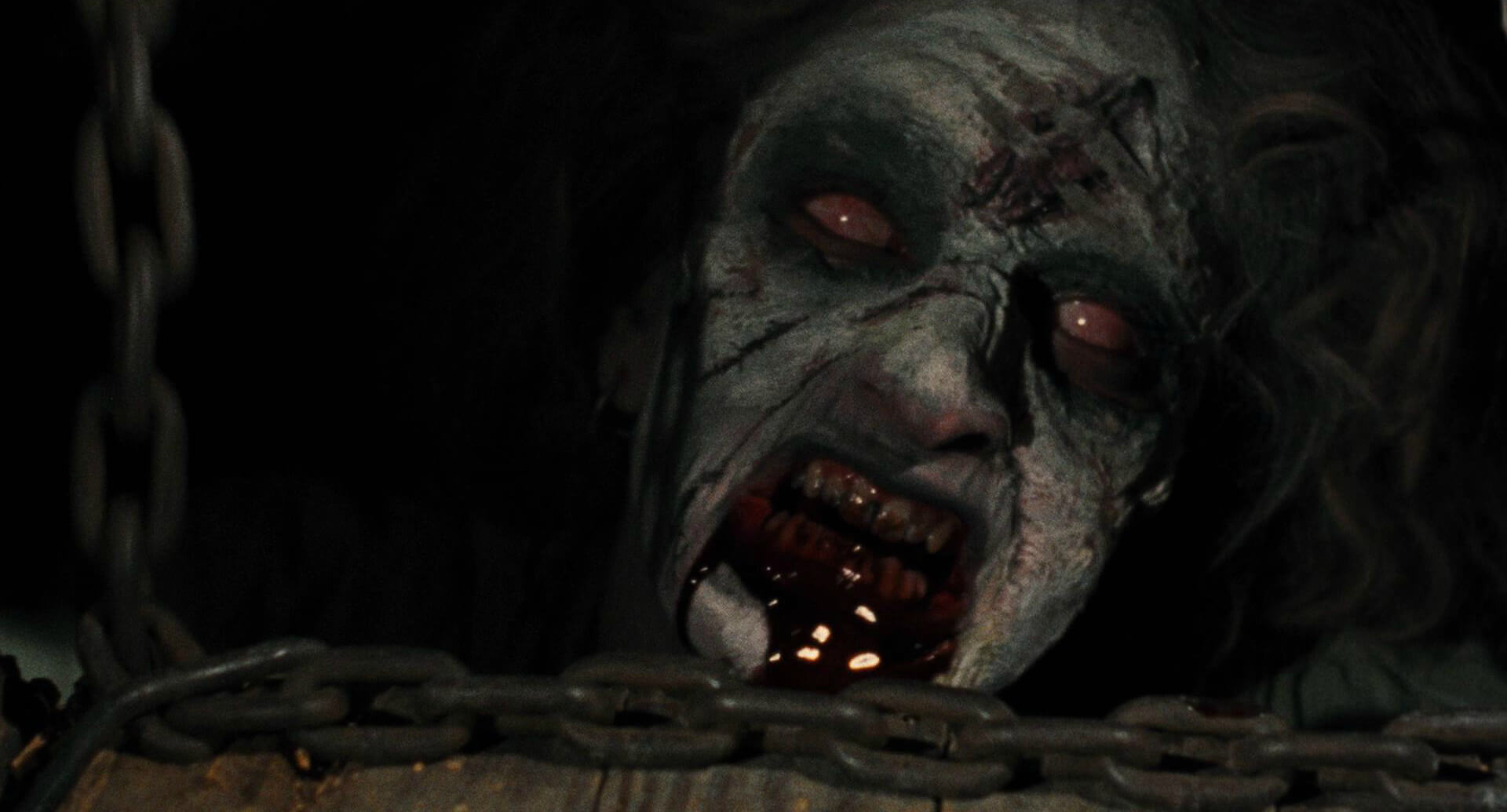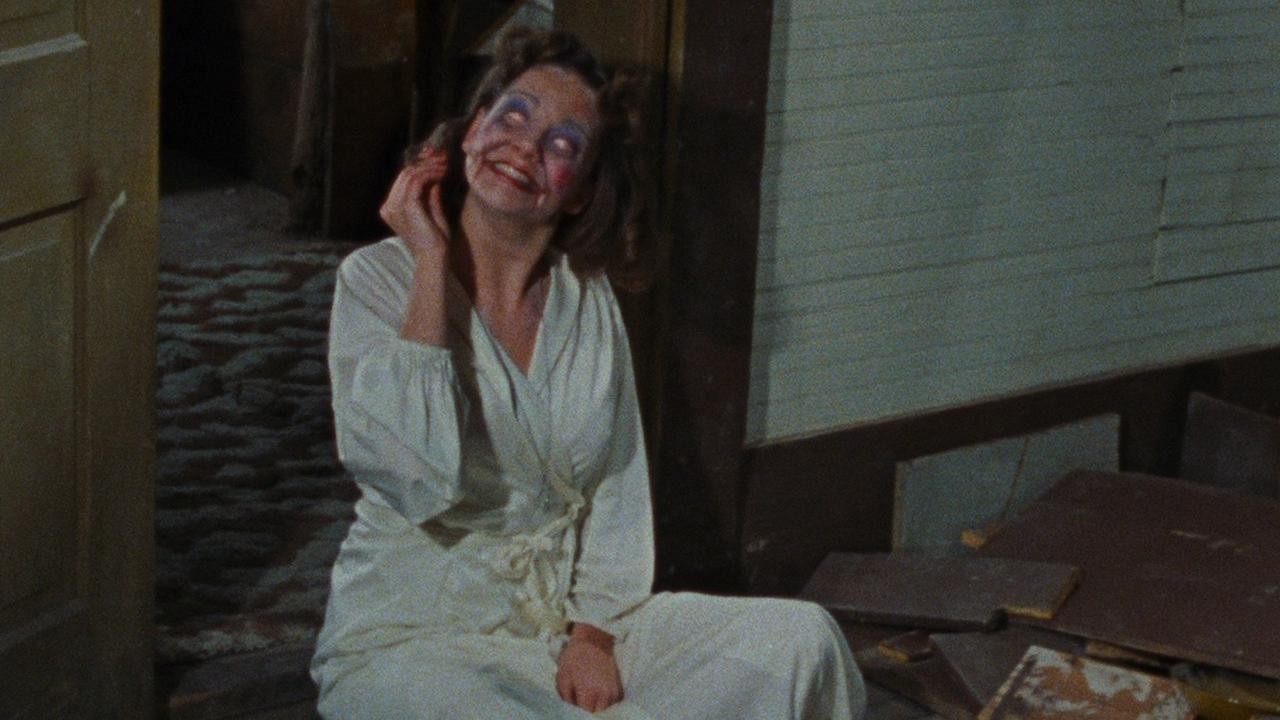THE EVIL DEAD. A nightmare that captivates, repulses, and amazes

It possesses the living, resurrects the dead, but it is decidedly far from lifeless passivity. Evil in Raimi’s film does exist, but everything dead here is actually full of life, unrestrained energy, and a maniacal joy in turning the Friday night of the heroes into hell. Wild enthusiasm infects viewers who, in the second half of the film, are inundated with blood oozing from every frame of The Evil Dead, a horror pushed to the limits of exaggeration, where fear unexpectedly turns into hilarity.
The plot of The Evil Dead is pretextual – a group of five students goes to a rented cabin in the woods for a pleasant weekend. There, they find an old, ugly book with strange contents and a tape recorder on which the recorded voice of an archaeologist explains that the mysterious find is the Sumerian Book of the Dead. Bound in leather and written in human blood, it contains techniques for resurrecting the dead and summoning demons. Of course, instead of immediately turning off the recording, the young people listen to the recorded incantations, thereby pronouncing a death sentence on themselves. Soon, they begin to turn into bloodthirsty monsters, and only one person remains on the battlefield – Ash. Isolated, he begins an uneven fight with his possessed friends.

It’s hard to write something new about Raimi’s debut, mainly because it’s a film widely known to every horror enthusiast. However, if someone has an image in their head of Bruce Campbell going wild on screen with a chainsaw instead of a hand and a set of one-liners for every occasion, they will be surprised, recalling the first film in which Ash never behaves foolishly, the typical goofiness present in later installments is absent, and a rather unexpected (especially in hindsight) tragedy is strongly emphasized. The original differs significantly from its sequels, which lean towards very dark comedy (Evil Dead II) and depict the main character as less flighty but still valiant hero, as seen in the third film of the series, Army of Darkness, and the currently aired TV series Ash vs Evil Dead. Although the second part is widely considered a more perfect work, fully showcasing the director’s talent for macabre entertainment, my preference has always been with the original. It may not be as crazy and professionally executed as the next film, but as a horror, it is more consistent and original.
This originality of The Evil Dead is not manifested in the plot, but in the presentation itself. The first shot already demands our attention, as the camera moves from the mist above the pond, swiftly gliding right above the water’s surface, somewhat clumsily avoiding obstacles, approaching a car driving on a forest road. The description of the scene might evoke the beginning of The Shining, but unlike Kubrick’s film, Raimi’s shot reveals the subjectivity of the viewpoint – there is no doubt that we are seeing through the eyes of something. Something decidedly inhuman, as it leaves no traces on the water’s surface; probably also something malevolent, if we trust our own intuition. Could anything good emerge from such an uninteresting setting?

The next scene of The Evil Dead somewhat disrupts this excellent opening, mainly due to the inexperienced actors and some misguided directorial choices. This is not surprising – the director was only twenty years old during the shooting, compensating for the lack of craftsmanship with enthusiasm and a myriad of wild ideas. Therefore, for a certain period, The Evil Dead gives the impression of an uneven production, where brilliant and unsettling moments alternate with scenes resembling an amateur production, a student exercise.
The future creator of Darkman wisely eliminates additional characters from the drama, leaving the most actorially competent Campbell on the battlefield, while hiding the rest of the cast under layers of excellent (and very thick) makeup. Suffice it to say that they work much better as demons than when they were human. Also, Joseph LoDuca‘s music, soon to become a regular collaborator on Raimi’s films and TV shows (the next installment of The Evil Dead, Hercules, Xena: Warrior Princess), has its better and worse moments. The composer can build a mysterious atmosphere with sparse but beautiful use of the piano, but when he tries to attack the viewer with typical horror notes, the effect is more amusing than frightening. However, all these shortcomings and mistakes of novice filmmakers are soon overshadowed by the loud scene of an attack and assault on one of the heroines by… a tree. From this moment on, what happens on screen often defies human understanding, and the creators try to shock the viewer with increasingly intense ideas right up to the end.

I could start a gruesome list of more macabre images that director Sam Raimi treats us to, ranging from driving a pencil into an ankle to various blood splatters. Such horrors fall under the category known as “splatter.” Raimi doesn’t immediately embrace the aesthetics of gore cinema in The Evil Dead, but once he starts, the horrors are endless. The contrast with the initial, very classical yet suggestive signals of evil forces surprises not only with the intensity of the attacks on the main character in the second half but also with the way it frightens and shocks the viewer. The debutant treats horror like comedy – instead of throwing gags, he amputates limbs; instead of slipping on a banana peel, he has the main character slide on blood. The pendulum in the clock sometimes hangs in the air, other times it seems to bore a hole in Ash’s head with its monstrous sound. The striking little swing or the spontaneously opening basement hatch are replaced by much more graphic effects, such as blood pouring from the walls, ceiling, flooding the light bulb, and projector. Campbell’s face in the finale serves as a canvas onto which the director pours as much red paint as he can. And all of this is often framed in an exceptionally spectacular way.
Watching the first The Evil Dead, one can clearly see Raimi’s greatest talent, effortlessly transitioning from horror to revulsion without turning his film into a brutal and nihilistic spectacle. The modest ($400,000) debut of the future author of the blockbuster Spider-Man trilogy remains entertaining until the end, perhaps not very intelligent or innovative, but very dynamic, captivating with the imagination and style of its creator. Brutality here is taken to a surreal extreme; the human body is treated as a blood reservoir that occasionally leaks. When demons disintegrate in the finale, green goo and worms emerge from their insides, and the mysterious book screams like a slaughtered pig. Can one take such images seriously? Probably not. Even the mentioned tragedy doesn’t contradict this exaggerated and somewhat kitschy presentation.

Raimi was never a subtle director, but he surprisingly excels in the romantic subplot and the later drama of the tormented lone Ash haunted by giggling demons, which can also assume more human faces. Besides physical attacks, they employ psychological terror, and the hero, brought to the brink of a nervous breakdown, can indeed call his horror exhaustive, as stated in the film’s full title – The Evil Dead, the Ultimate Experience in Grueling Horror. But “gruel” is also the demonic goo, probably green and wormy. The jokes here seem hidden between the lines, not as obvious as in the grotesque sequel, but each subsequent viewing brings increasing amounts of joy.
Perhaps that’s why the first Evil Dead is called a cult film. It doesn’t scare as much as the best genre achievements, and it can’t boast perfect execution or an outstanding script. However, it provides a sense of engaging with a work that is perfect in its own way – sincere, daring, and made with love for cinematic material. Banned in many countries during its premiere (even landing on the infamous video nasties list in the UK), heavily censored elsewhere, it hasn’t lost any of its energy and ruthless imagination, remaining a horror classic that deserves recognition. Yes, the second part is even more manic, softening the violence with a healthy dose of black humor. The original, however, takes no prisoners – it captivates, repulses, and amazes – remaining a nightmare that one returns to with delight.

